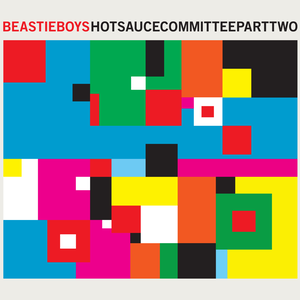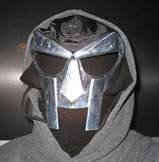I have the education of a Beastie Boy. All three went to my middle school. One went to the same High School as I did. And one graduated from the same College. Yeah, I’m bragging. And you’re just jealous.
Let’s rank all their albums!
9. Some Old Bullshit (1994 reissue)

Old stuff from their pre-hip hop punk days. Surprisingly, it’s pretty good for a bunch of kids fucking around and banging on instruments they didn’t know how to play. Key tracks are Egg Raid on Mojo, the dub Beastie Revolution, and the crank-caller cut Cooky Puss.
8. Licensed to Ill (1986)
Mike D, MCA, and Ad-Rock may have started out making frat-boy rap (see the songs Fight for Your Right and Girls), but it’s a mistake to underestimate their first album. Before Licensed to Ill, the trio had released Cooky Puss, a single where they prank called a Carvel Ice Cream Cake, and made a couple punk songs. This album, their debut, became the first rap album to hit #1 on Billboard’s album chart, leading to further criticisms of cultural appropriation. And the immature youngsters wanted to title the album Don’t Be A Faggot, but were forced not to by Columbia Records, leading to concerns that the band was homophobic. And it got them a tour with Madonna, which made some heads call them sell-outs. All these critiques are valid. They also don’t tell the entire story.
Licensed to Ill has some very strong material, including No Sleep Til Brooklyn and Paul Revere. It earned five mics from The Source. It announced with its first song that the group had The New Style (not “a” new style—“the” new style). It broke ground for rock/rap crossover songs like Run DMC’s Walk This Way. Before Licensed to Ill, rap music was largely seen as an “urban” genre. But from now on, it would be a commercial monster and the industry would begin to see that hip hop could reach a wide range of genres.
Over time, this record hasn’t aged well (see the criticisms above). But it is foolish to deny its significance.
7. The Mix-Up (2007)

Their instrumental album. It’s good. It’s really good. I’m just not a huge fan of purely instrumental albums. If you are, you’ll probably rate this one higher than I did.
6. Hot Sauce Committee Part Two (2011).

No, there is no part one. This is the band’s final album and their plan to release two parts was made complicated by MCA’s illness and ultimate death due to cancer. It’s hard not be sad knowing what happened with this album, but it’s also hard not to enjoy the listen. It shows that decades into their careers, the Beastie Boys had finally gotten the recognition they deserved as groundbreaking, powerful forces in the world of rap music.
Key tracks: Too Many Rappers (featuring Nas), Make Some Noise, Don’t Play No Game That I Can’t Win (feat. Santigold).
5. Hello Nasty (1998).
Four years between albums?!? That would be unheard of nowadays. But then again, albums nowadays mostly suck–there are good songs, but they’re overstuffed affairs—and usually artists produce them every few months. So taking the time to make an album that’s all filler, no fluff, gets my appreciation. Even if today’s music market doesn’t sustain the “album model.”
Hello Nasty had one of the band’s biggest hits, Intergalactic, and won two Grammys.
Essentially, it perfects what by now has become the signature Beastie sound: Light sampling and live instrumentation under forcefully delivered bars about how great they are as a group and how profound and mystical the world can be. The Beasties continue to fascinate with this record.
Key songs: Intergalactic, Body Movin’, Three MCs and One DJ, Electrify.
4. To the 5 Boroughs (2004)
Another platinum album for the boys. To The 5 Boroughs relies on fusing together the styles that the BBs have used in their prior 5 albums, and as a result it feels polished and well-crafted, but doesn’t really move the needle in terms of hip hop as a genre. And let me be clear: There’s nothing wrong with that. Very few rappers have one brilliant album. The Beastie Boys have at least three—four if you love this one. This is still a great record—it’s just not AS great as the others ahead of it on this list.
This album came after Mike D was sued by James Newton for sampling the latter’s song, “Choir,” on “Pass the Mic” (from Check Your Head). Mike won, with the judges holding that a small sample as part of a larger musical work is wholly permitted and does not constitute copyright infringement. So even if Tt5Bs doesn’t convey the impact and influence of this band, the litigation helped the genre continue to move forward.
Key tracks: Ch-Check it Out, 3 the Hard Way, It Takes Time to Build, An Open Letter to NYC.
3. Check Your Head (1992)

Five years after they recorded their “frat rap” debut and three years after they did their experimental masterpiece Paul’s Boutique, the Beastie Boys reinvented themselves a third time. Check Your Head, produced by the boys and Money Mark, fused the rock/power pop sensibilities of their first album—less the sexism—with the experimentalism of Paul’s Boutique. The result was a collection of a few hits, funky instrumentals, grunge-y production, and genre-busting numbers that caught the world of hip hop completely off guard. At a time when rap was moving from the “trying to be safe for radio” phase of the ‘80s to the “tell it like it is” grime and gangsta rap of the early ‘90s, The Beastie Boys showed that the genre was far more versatile than anyone gave it credit for.
Key tracks: Pass the Mic, Gratitude, So Whatcha Want.
2. Ill Communication (1994).
A triple-platinum, #1 record that finally got the BBs the accolades and recognition they deserved. Less experimental than Check Your Head (which came right before it), Ill Communication nevertheless continued to have the Beasties playing their own instruments, creating musical beds between some of the songs, but also contained monster hits. MONSTER hits. And cameos by rap legends Biz Markie and Q-Tip.
Key tracks: Sabotage, Sure Shot, Root Down, Get it Together.
1. Paul’s Boutique (1989)

This was the Boys’ masterpiece. As if to respond to all the criticism that followed Licensed to Ill, the trio established themselves as highly imaginative rappers capable of multiple styles of delivery. The album was produced by The Dust Brothers with lots of input from the Beasties, and the music on the album is all samples.
In retrospect, everyone recognizes this album as pure genius—one of the most important and best albums ever made. But at the time, nobody knew what to make of it. It didn’t sell well, and from here the BBs would go on to make two very commercially successful and much more “straight forward” albums in a row (Check Your Head and Ill Communication). Coming from the “lowest common denominator” of Licensed to Ill into a groundbreaking, ahead-of-its-time production, Paul’s Boutique established this band as one that would never be constrained by expectations.
Key tracks: B-Boy Bouillabaisee, which is basically one long symphony similar to the final tracks on The Beatles’ Abbey Road; Egg Man, which combined punk and rap; Hey Ladies (the most “normal” song on the album); and…Frankly, every track on this record is incredible but they also need to be heard together. This is the rare example of a true hip hop ALBUM—not a collection of songs loosely held together with skits.

